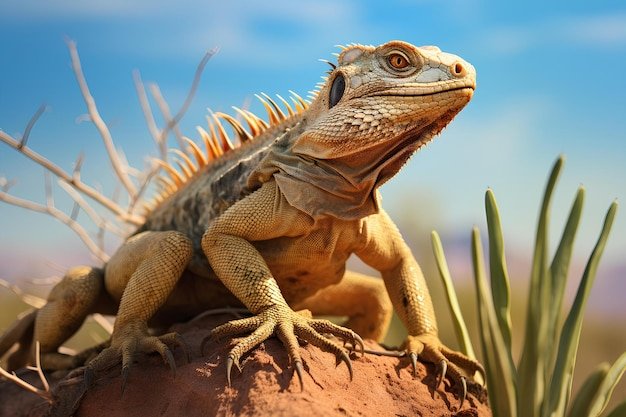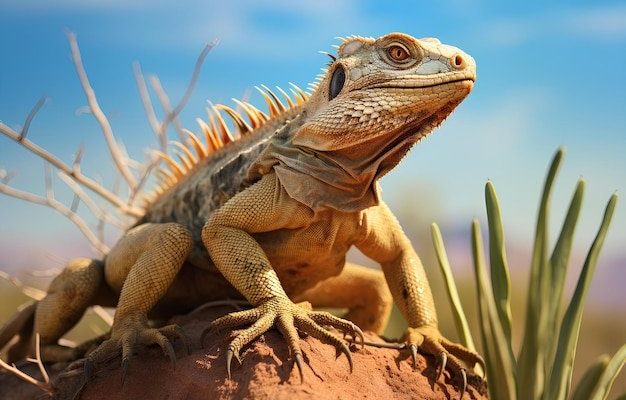
Imagine the desert: wide open spaces, bright sunlight, and rocky terrains. That’s the world your iguana is used to. To replicate that at home, you’ll need to focus on several key elements, from temperature and humidity to suitable substrate and decor. Let’s break down how you can create a thriving environment for your new green friend.
Understanding the Desert Iguana’s Natural Habitat
Desert iguanas are native to the arid regions of the southwestern United States and parts of Mexico. They’re well-adapted to hot, dry conditions. *One of the biggest mistakes new owners make is overlooking these natural conditions.* Without the right setup, your iguana could become stressed or even sick.
In the wild, these lizards can bask in the sun during the day and find shelter in burrows or under rocks to escape the heat. Knowing this can help you choose a habitat that allows them to replicate their natural behaviors. A bright, spacious setup with spots for both basking and hiding will help mimic those conditions and keep your iguana happy.
Choosing the Right Terrarium Size
The size of the terrarium is essential. Desert iguanas can grow up to 2 feet long, so they require plenty of space to move around. *A good rule of thumb?* Aim for a terrarium that’s at least 30 gallons for one iguana. Bigger is always better if you have the room—more space means more opportunities for exercise and exploration.
When selecting a terrarium, consider one with a long, horizontal layout rather than a tall one. Iguanas are more ground-dwelling and prefer to move sideways. Additionally, ensure that the terrarium has a secure lid since iguanas are known to be escape artists. You wouldn’t want to come home to a missing pet!
Temperature and Lighting Requirements
Temperature regulation is one of the most crucial aspects of setting up a habitat for your desert iguana. They thrive in temperatures ranging from 80°F to 100°F during the day. You’ll need a basking spot that’s even warmer, ideally around 110°F, where they can soak up the heat.
To achieve this, use a combination of heat lamps and an under-tank heater. It’s also important to create a temperature gradient within the terrarium, allowing your iguana to choose where it feels most comfortable. *Honestly, having a thermometer in both the basking area and the cooler side will help you keep an eye on the temperatures.*
Lighting is just as important as heat. Desert iguanas need UVB lighting to help them synthesize vitamin D3, which is vital for their bone health. Make sure to provide 10-12 hours of UVB exposure each day, mimicking their natural light cycle.
Humidity Levels: An Often-Overlooked Factor
Another aspect many potential iguana owners overlook is humidity. Desert iguanas prefer a humidity level of around 20% to 40%. Too much humidity can lead to respiratory issues or fungal infections, while too little can cause shedding problems or dehydration.
Using a hygrometer will help you keep track of humidity levels. If you find your setup is too dry, consider lightly misting the terrarium a few times a week or adding a shallow water dish to provide some moisture. However, ensure it’s cleaned regularly to avoid becoming a breeding ground for bacteria.
Choosing the Right Substrate
The substrate you choose can significantly impact your iguana’s health. Natural options like sand or coconut coir can work well, but avoid substrates like cedar or pine shavings, which can be harmful. Sand allows your iguana to dig and burrow, mimicking its natural behavior, while coconut coir retains some moisture without becoming too wet.
Remember to keep the substrate clean and free of waste. Spot cleaning daily and changing the substrate every few weeks will help maintain a healthy environment. If you notice your iguana eating the substrate, you might want to switch to something safer or check its diet.
Decor and Enrichment Items
Just like you might add personal touches to your living space, your iguana’s habitat should feel a bit like home for it. Adding decor—like climbing branches, rocks, and hiding spots—will not only make the terrarium aesthetically pleasing but also give your iguana essential places to explore.
Don’t forget about creating hiding spots with items like hollow logs or decorative caves. These spots help your iguana feel secure, reducing stress. You can also use plants, but make sure they’re non-toxic. *Adding a few artificial plants is a great option as they require no maintenance and won’t add humidity.*
Feeding and Watering: Not Just an Afterthought
An often-overlooked part of habitat setup is the feeding station. Make sure you have shallow dishes for food and water. Desert iguanas primarily eat vegetation, such as leafy greens, flowers, and some fruits. Offering a varied diet will help keep your iguana healthy and happy.
Water is just as important. While iguanas get some moisture from their food, they still need access to fresh water daily. It’s best to change the water regularly to prevent bacteria buildup. If your iguana seems to prefer drinking from a dish rather than soaking in one, don’t worry—many do!
Regular Care and Maintenance
Set yourself up for success by committing to regular maintenance. Keeping the habitat clean not only looks good but is crucial for your iguana’s health. Regularly check and adjust temperatures, clean water dishes, and spot clean the substrate.
Creating a schedule for these tasks will help you stay on top of it. *Honestly, developing a routine not only benefits your pet but also makes it easier for you to remember what needs to be done.* Regularly checking your gear, like heat bulbs and UVB tubes, will also ensure everything is functioning properly.
In conclusion, setting up the best habitat for a desert iguana involves a bit of planning and care. By creating an environment that replicates their natural habitat—complete with appropriate temperatures, humidity, lighting, and decor—you’ll help your iguana thrive. Remember, a happy lizard leads to a happy owner! As you dive into this exciting journey, know that patience and attention to detail will go a long way in ensuring your iguana feels right at home.

